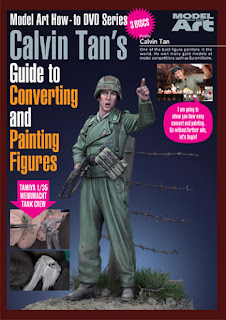SS-Obersturmführer, Das Reich, Russia 1941
.
Calvin

In the words of Wilbur Smith "War is the game played by old men with the lives of the young". The pawn in this game is the combat soldier, represented by the miniature toy soldier; an insignificant being on the battlefield. Combat is the most intense moment of war, where life and death balances on a knife's edge. The results are terrifying and reveal the worst part of our human nature. Conversely, there are moments when it exudes the best of our human spirit. Most of the miniatures you see here are diligently researched from historical sources and handcrafted between scales of 1/35 to 1/16 (approx 50mm to 120mm). The intricate rendition of human expression and fine details not only demonstrates the level of craftsmanship but also serves as a reminder of the fragile nature of human life. I represent no political bias though my miniature creations. My aim is to portray humanity through the chronicles of military history and thus it is my pleasure that I present to you my weblog Perspectives in Miniature.


In conjunction with AK Interactive, this exclusive Gen 3 acrylic paint set is specially composed with the essential colours that I use to render WWII German Uniforms. It contains 18 colours and a small pamphlet with my personal colour mixes. If you are keen to acquire all the colours on my palette to paint a field grey tunic, a splinter pattern zeltbahn, an oak-leaf pattern smock or the Kharkov anorak, look no further, this is the set for you to get started.

This instructional DVD published by Model Art magazine was primarily developed for the beginner armour and diorama modeller in mind. The video presentation will feature a variety of easy to master techniques used to render a 1/35 scale plastic injected moulded figure.Topics include proper paint application techniques, choice of brushes as well as some little tricks for painting fine detail. It is fundamentally a showcase of some of my methods and techniques for painting military figures and I am certain it will prove beneficial for any modeller who wishes to improve on figure painting. It is currently available in both Japanese and English.

This video presentation documents the process of rendering a highly detailed 1/35 scale after-market resin figure. Watch as I take the viewer through the process of rendering of leather, uniform insignia as well as camouflage patterns using the techniques and materials presented in the beginner's guide to achieve convincing results. It is available in both Japanese and English.

In this third instalment, I will share my techniques and materials to customize and detail an inexpensive stock plastic figure. Watch as I take you through the steps on how I modify a pose, model details such as hands, belts and webbing and insignias. Learn about working effectively with epoxy putty as well as plastic styrene and paper. As a continuation from my first two DVDs, I will demonstrate how to model and paint a simple groundwork as well as an alternate approach using a monochromatic underpainting to render both a field grey tunic and the World War 2 German Splinter Camouflage pattern on a helmet cover. If you have enjoyed and benefitted from those previous titles, this edition will be a welcome addition to your journey in scale figure modelling – regardless of your current skill level. It is my sincere hope that this could inspire you to embark on your own creative adventure in this fantastic hobby.
Clubs / Associations

.
MILITARY ILLUSTRATORS
Where to Makan(Malay for Eat) in Singapore


Calvin Tan Calvin Tan Calvin Tan

5 comments:
It's always great to see you in action, my friend!
Best regards.
Can you explain the maroon undercoat please. Is this another new technique you are trying?
Hello Calvin!
Im Gonzalo from Spain and I have your Modelling Waffen SS figures book. I want to know which epoxi do you use in the book. It looks much better that the milliput (red box) that i use. Could an epoxi like Andrea sculp, milliput superfine or any other fine epoxi, be able to make clothes, like in the book?
Thanks Calvin
Deano,
this is not a new technique but rather a dated approach adopted by the old painting masters such as Titan for using a dark undercoat for painting. There are no specific colors for this operation. My preference in this case of using a maroon color is such that I wanted an overall warm perspective of the final.
Hola Gonzalo,
muchos gracias compra mi libro.
The putty I use for the book is like a softer version of the A+B putty. You can also use the Miliput Superfine but you need to wait about 30mins for it to firm up a little before rolling it out with baby powder.
Calvin
Calvin,
Thanks for the answer, I'm looking forward to seeing this finished. I find just looking at your painting steps has helped me as a figure painter.
If you ever decide to publish a book on how to paint figures, I'm in!
Post a Comment